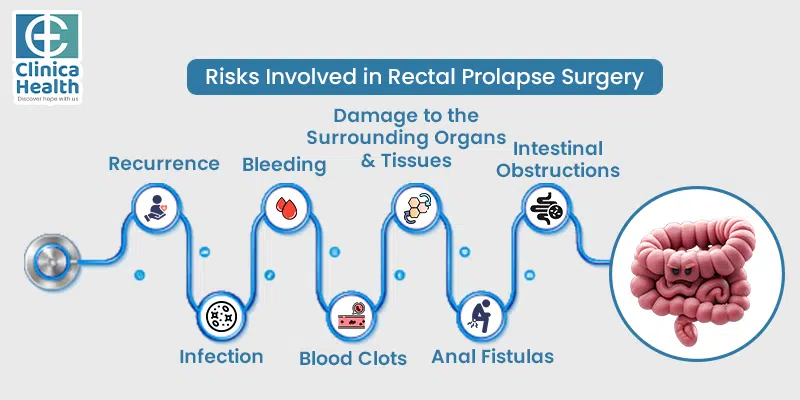-
 Call Now:
8010 552 552
7595 838 844
Call Now:
8010 552 552
7595 838 844
-
 Email Me:
[email protected]
Email Me:
[email protected]
Have you recently noticed a reddish lump around the anus? It might be a sign that you are having rectal prolapse, a condition in which the rectum loses its attachment and protrudes through the anus. For many patients, rectal prolapse is a humiliating condition and affects the patients both emotionally and physically. The condition can occur in three phases:
Rectal prolapse is most likely to affect adults, especially women above 60 years. While rectal prolapse is indeed an alarming disease; however, it can be treated with rectal prolapse surgery.
There are a number of surgical treatment options to manage rectal prolapse depending on the patient’s age, health issues, amount of the prolapse and result of other tests.
Perineal (Rectal) Repair Procedure: The prevalent approaches under this category include the following:
Altemeir Procedure: During the procedure, the section of the rectum that is protruding out is cut, and the remaining sections are joined together.
Delorme Procedure: In contrast to the other procedure, only the inner surface of the falling rectum is removed in this operation. After that, the outside layer is folded and stitched, and the inside lining’s cut ends are also stitched together.
Abdominal Repair Procedure: It is a type of rectal prolapse surgery where the surgeon makes an incision in the abdominal muscles and repairs the rectal prolapse. The procedure can be done either in a conventional (open )way or a laparoscopic method. Unlike open procedure, which involves making large incisions, in the laparoscopic method, the surgeon makes small incisions in the abdomen through which a laparoscope (a thin tube with a camera attached) is inserted. The laparoscopic allows the surgeons to monitor the abdomen and perform the surgery.
The two most prevalent approaches under this category are:
Rectopexy: It is a method where the falling rectum is fixed (either by open or laparoscopic method) to the surrounding structure, particularly the sacrum.
Resection: This is done when the situation is severe. Here, the last part of the rectum is removed, which is then followed by rectopexy, where the remaining healthy ends of the rectum are then fixed to the surrounding tissues.
The success rate of any rectal prolapse procedure depends upon the patient’s age, health and state of the surrounding tissues. In fact, surgery is the most effective treatment option for the condition, especially abdominal repair.
However, just like any other surgical intervention, rectal prolapse surgery even carries some risks if performed by an inexperienced surgeon. Here are some of the possible complications.
Hence, whenever you are undergoing rectal prolapse surgery, make sure to get it done by a certified and skilled doctor.
Before your rectal prolapse surgery, your surgeon will provide you with some instructions that need to be followed to ensure that the procedure goes smoothly.
Medical Evaluation: Don’t forget to inform your surgeon about your existing medical conditions, allergies, previous surgeries and current medications.
Dietary Eestrictions: Avoid solid heavy meals at least 24 to 48 hours before the procedure. Stick to a light liquid diet to ease digestion.
Stop Smoking and Drinking: Refrain from smoking and drinking for a certain period of time.
Bowel Movements: You will be given stool softeners or laxatives to make sure that the bowel movement is clear for a smooth surgical procedure.
Take a look at what patients can expect before, during and after the procedure.
Undergoing tests: Prior to the procedure, you will be asked to undergo certain blood and imaging tests to confirm the severity of the condition.
Following pre-procedure instructions: Make sure to thoroughly understand and follow your doctor’s instructions to avoid any complications during the procedure.
During rectal prolapse surgery, the surgeon gives anesthesis to numb the area to minimise any kind of discomfort and pain. Depending on the falling rectum and type of the procedure, it might take around 2-4 hours to complete the method. After the process is done, you will be kept under supervision for some days to allow the doctor to monitor the condition.
After you are discharged from the hospital, it will take some time for complete healing and recovery. Bowel function might be the same or can deteriorate a bit. Your doctor will prescribe a pain reliever to get you relief from the pain.
You may also need to include:

The timeline for the results after rectal prolapse surgery to appear usually varies among patients. In the initial days, one can experience some kind of discomfort, and it is completely normal.
But soon after 3-4 weeks, the body starts to heal, and the symptoms start to subside. You will also notice significant changes in bowel control. The long-term result can take around a few months, and patients can resume their daily activities.
Don’t feel embarrassed to seek medical advice if you have rectal prolapse. It is important to discuss your symptoms with your healthcare provider as soon as possible to prevent complications. It is to be remembered that the condition will not improve until you undergo rectal prolapse surgery; rather, it will deteriorate. Hence, opt for surgery by an experienced surgeon and lead a healthy quality of life.